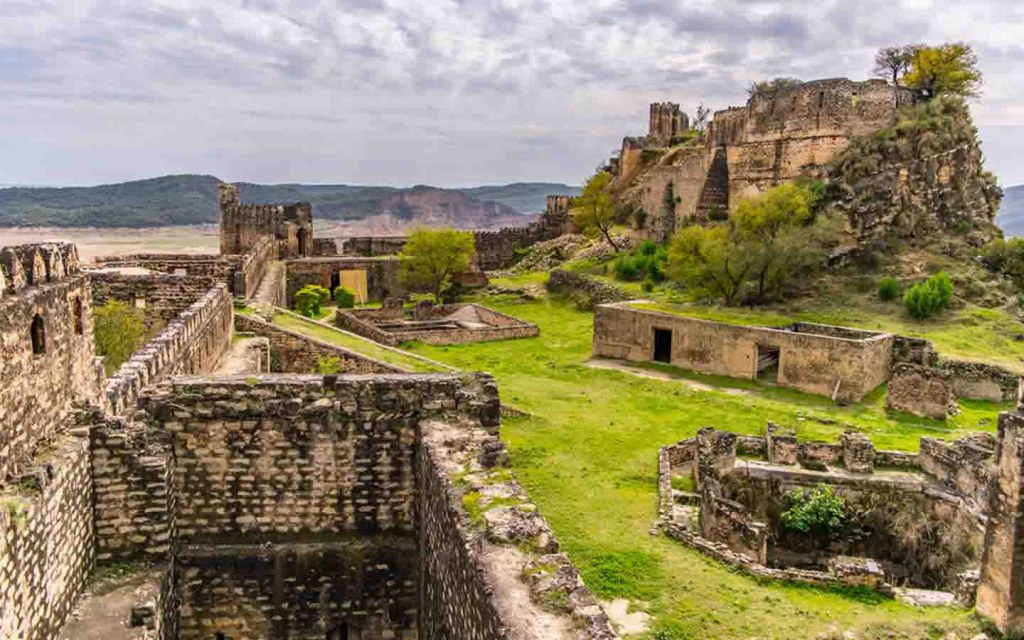
Article by
Located on the summit of a hill, Ramkot Fort is built over the site of an old Hindu Shiva temple. Three sides of this hill top are surrounded by River Jhelum (ancient “Vitasta”). During excavations, relics from 5th & 9th century AD were discovered near one of the surrounding temples. During the 16th-17th centuries, the Muslim rulers of Kashmir in order to secure their boundaries built numerous Forts. Ramkot, sitting atop at the confluence of the river Jhelum & Poonch is one of them. The Sikh Maharaja of Kashmir further fortified Ramkot.
Ramkot Fort is located on the opposite side of the Mirpur town, one has to cross the Mangla Lake by boat to reach there. A 10 minute travel by road from Mirpur leads to Sukhian and nearby army water sports club from where boats are available to travel to Ramkot Fort. It takes about 45 minutes to reach there.
Though on the verge of collapse, it still offers everything to those who have a thing for past glory, nature, and history. The masterpiece of the glorious architecture of 12th Century AD, the fort was built in 1186 by Sultan of Ghurid clan namely Ghiyath al-Din Muhammad, at top of a hill surrounded by blue waters of river Jhelum and Poonch on three sides. Ramkot Fort presents a beautiful landscape with a blue river in the background and a majestic view from the top. The fort is located on the confluence of two mighty rivers and seems like a crown on a vertical cliff from blue waters. Due to its peculiar architecture, the Ramkot Fort is distinct among fortresses built in the Kashmir region.
The architectural characteristics of Ramkot Fort suggest that it was also constructed in the same timeperiod, when Mangla and Muzaffarabad Forts were built. People, including men, women, children, who reached here to explore history found the fort’s location strategically more important than the forts as Lahore Fort (Shahi Qila), Peshawar Fort (Qila Bala Hisar) and Rohtas Fort. It can be reached through a gateway provided in the southeast corner of the fort. It is the only entry/exit point for the whole fortified area. The gateway is strategically designed with canons covering almost every angle.
One can clearly see that the whole complex is slowly turning to ruins and as the times pass, it will continue to be so. The renovation of the fort can be a big attraction for tourists, nature-lovers, hikers, and water sports-lovers and earn huge revenue for the administration, as well as provide a decent livelihood for the locals of Dadyal Tehsil.
Ramkot Fort was built in the middle of blue waters of Jhelum and Poonch rivers and now surrounded by waters of Mangla Dam, the second largest water reservoir of Pakistan and 16th largest in the world, from all four sides. People can reach this site by using boats mostly from Haveli Bhathar village of Sayakh area of Dadyal Tehsil of Mirpur district. The other way to approach the fort is via a boat from the water sports club located in Mangla Dam, which, after an almost 10-minute ride, would reach the northern extreme of the dam. Here, one can find a giant fort structure located on the summit of the hill.
A short but steep climb uphill takes you to the fort. This tricky location must have been a strategic plus point for this fort in the past, but these days, it has become the reason for its isolation and wilderness. The structure of Ramkot Fort epitomizes the Muslim military architecture, being filled with war mechanism. There is a water tank at the front against the background of a building on a raised plinth.
 Monthly "Azeem English Magazine", launched in 2000, records the information about diverse fields like mental health, literature, research, science, and art. The magazine's objective is to impart social, cultural, and literary values to society.
Monthly "Azeem English Magazine", launched in 2000, records the information about diverse fields like mental health, literature, research, science, and art. The magazine's objective is to impart social, cultural, and literary values to society.
+92 51 88 93 092
First Floor, RAS Arcade, Eidhi Market, Street#124, G-13/4, Islamabad, Pakistan, 44000.